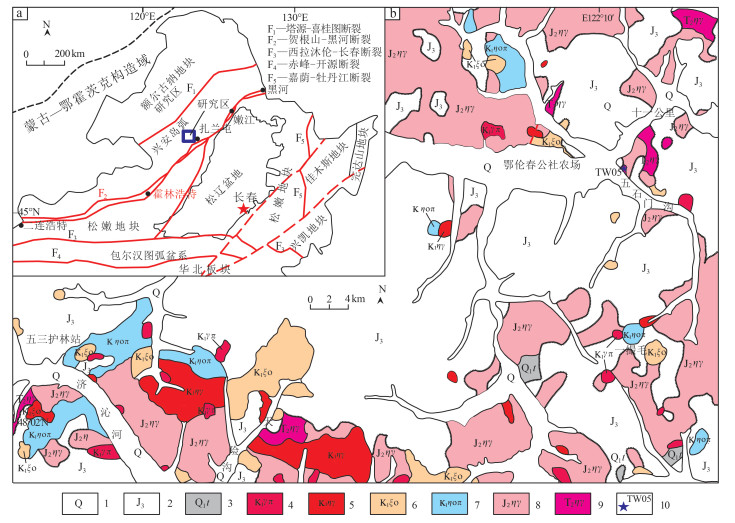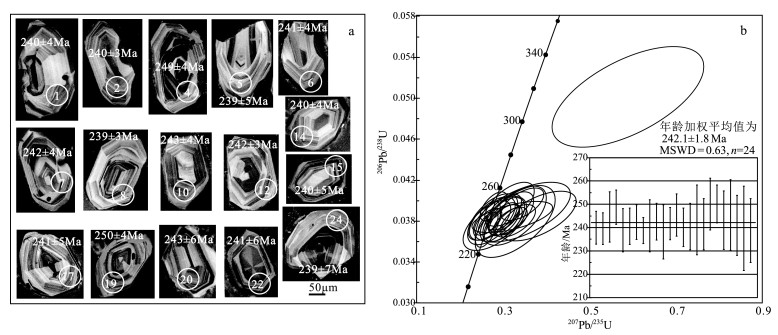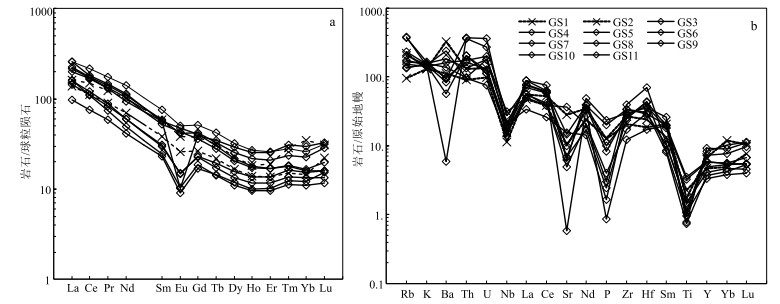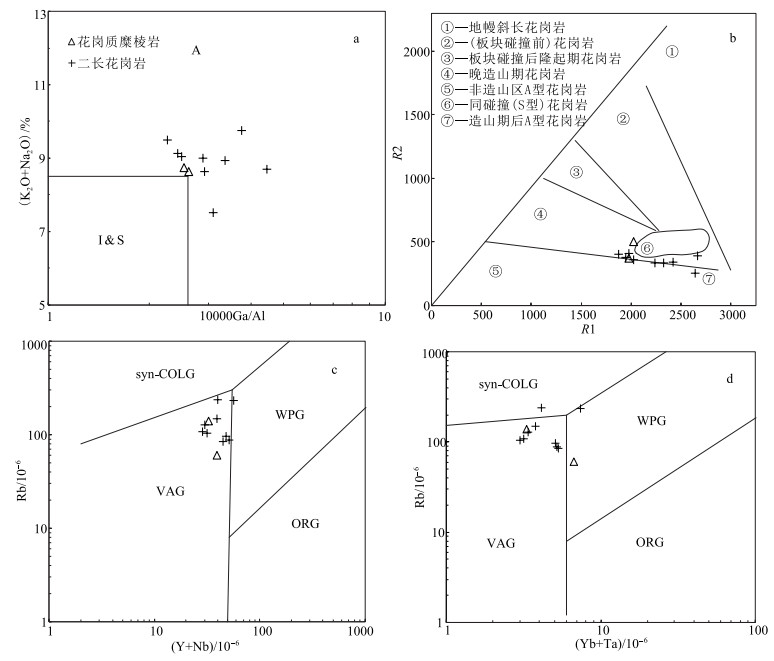Tectonic evolution of Indosinian monzogranite in Zhalantun area, Inner Mongolia: Constraints of geochemistry and zircon U-Pb age
-
摘要:
扎兰屯地区位于贺根山-黑河构造带中段,区内发育韧性变形叠加的印支期花岗岩。对扎兰屯西北地区印支期糜棱岩化二长花岗岩进行了详细的岩石学、岩石地球化学和锆石U-Pb同位素测年,探讨其岩石成因及区域动力学背景。通过LA-ICP-MS锆石测年获得扎兰屯西北地区糜棱岩化二长花岗岩的结晶年龄为242.1±1.8 Ma,形成时代为中三叠世。地球化学研究显示高硅、高碱、低钙镁特征,属于准铝质-弱过铝质高钾钙碱性花岗岩。岩体富集大离子亲石元素(Rb、U、Th、K),亏损高场强元素(Nb、Ta、Ti),具Zr、Hf正异常,总体表现为不相容元素逐渐富集,Sr、P、Ti亏损程度增加,表现出中等强度负Eu异常。结合区域资料认为,印支期二长花岗岩形成于古亚洲洋闭合碰撞造山后,构造环境由挤压向板内稳定-伸展的变迁阶段。
Abstract:The Zhalantun area is located in the center of the Hegenshan-Heihe structural belt.Indosinian granites with superimposed ductile deformation are developed in the area.Based on the detailed studies on petrology, lithochemistry and zircon dating of the Indosinian mylonitized monzonitic granite in the northwestern Zhalantun area, its petrogenesis and regional dynamics background are discussed.LA-ICP-MS zircon dating yields the crystallization age of 242.1±1.8 Ma for the mylonitized monzonitic granite, indicating it was formed in the Middle Triassic.Geochemical studies show that it is of quasi-aluminum-weak peraluminous high-potassium calcium-alkaline granites with high silicon, high alkali, low calcium and magnesium.It is enriched in large ion lithophile elements(Rb, U, Th, K), depleted in high field strength elements(Nb, Ta, Ti), with positive Zr and Hf anomalies, and in general, incompatible elements are gradually enriched.The increasingly depletion of Sr, P and Ti and the moderate negative Eu anomaly were observed.Based on the regional data, it is suggested that the Indosinian monzonitic granite was formed in the compression-extension transition stage of the tectonic environment after the Paleo-Asian Ocean closed collision orogeny.
-
Keywords:
- monzoranite /
- zircon U-Pb dating /
- Indosinian period /
- Zhalantun area /
- Inner Mongolia
-
研究区位于兴蒙造山带东段,由北向南依次为额尔古纳地块、兴安地块和松嫩地块,经历了古生代多块体拼合作用过程和中生代陆内演化过程的叠加,地壳结构、构造相对复杂[1-2]。大兴安岭北段发育大面积的晚中生代火山岩,由于研究区内火山岩研究对象不同,众多学者对火山岩期次的划分与厘定存在分歧。关于火山岩形成的构造环境问题存在争议,先后有地幔柱成因[3-4]、板内成因[5]、蒙古-鄂霍茨克洋俯冲成因[6-8]、古太平洋俯冲成因[9-10]等多种观点。另一方面,大兴安岭北段的中西部地区目前有较多的年代学资料,但东部地区火山岩年代学及火山岩构造背景的研究较滞后。因此,本文对研究区不同期次火山岩开展详细的研究工作,进一步划分火山岩浆活动期次,讨论火山岩的成因及形成的构造环境,为晚中生代火山岩的构造环境提供依据。
1. 地质背景及岩石学特征
龙江盆地位于黑龙江省龙江县境内,内蒙古自治区东部,所在区域为古生代陆壳侧向增生区,亦为兴安地块和松嫩地块的缝合区(图 1-a)。在地质特征上,龙江盆地是由多个发育在海西褶皱基底上,以早白垩世为主体的一群中小规模的断陷湖盆组合而成,形成条件相近的断陷,具有各自独立的沉积体系。
![]() 图 1 大兴安岭北部构造单元划分[11](a)和龙江盆地地质简图(b)Figure 1. Tectonic setting map of the northern Da Hinggan Mountains (a) and simplified geological map of Longjiang basin(b)
图 1 大兴安岭北部构造单元划分[11](a)和龙江盆地地质简图(b)Figure 1. Tectonic setting map of the northern Da Hinggan Mountains (a) and simplified geological map of Longjiang basin(b)区内出露的地质体主要包括晚古生代大石寨组、花岗岩体及晚中生代火山岩。其中,大石寨组为一套经过低级变质作用改造的火山-沉积岩系[12],其形成环境为浅海并伴随较强烈的火山活动;花岗岩主要由花岗闪长岩和二长花岗岩组成,为一套高钾钙碱性系列岩石。盆地内出露的晚中生代地层自下而上为下白垩统龙江组、光华组和甘河组,是大兴安岭北段火山盆地的基本类型。龙江组为偏中性火山岩,以安山岩、安山质凝灰岩、火山角砾岩、凝灰质细-粉砂岩夹少量英安岩、英安质凝灰岩为主,与下伏二叠系和侵入岩呈角度不整合接触。光华组为偏酸性火山岩,以流纹岩、碱流岩、流纹质凝灰岩、流纹质沉凝灰岩夹薄层凝灰质细-粉砂岩为主,灰白色粘土岩及沉凝灰岩中富产叶肢介、介形虫、淡水双壳类、腹足类、昆虫及植物化石,属于中期热河生物群。甘河组为偏中基性火山岩,以玄武岩、橄榄玄武岩和玄武安山岩为主,厚度大于82.6m,喷发覆盖于下伏地层之上。
本文涉及的光华组在光华村—兴义村一带分布,出露面积约89km2,碱流岩出露于大景星山附近(图 1-b),沿新兴村-大景星山-东临山进行地层剖面实测和采样,详细考察了龙江盆地碱流岩的野外产状、空间分布特征和野外地质关系。大景星山呈椭圆形,长轴方向为北北东向,与区域构造(断裂)走向一致,地貌表现为中央山峰高耸,周围是阶梯状下降的多轮环状山。碱流岩以大景星山为中心向四周溢流(图 2-a),覆盖于下部流纹质-英安质火山碎屑岩之上,流面发育(图 2-b),岩性稳定。本次研究的样品(PM412TW25)采自大景星山碱流岩中心部位,即北纬47°09′28″、东经122°56′27″。
碱流岩呈灰白色-灰紫色,斑状结构,基质具有球粒-显微嵌晶结构。斑晶成分为透长石(10%~ 15%),半自形板状,局部聚斑状,发育横向裂纹(图 2-c),卡氏双晶,粒径0.4~3.0mm。基质以长英质放射状、扇形球粒为主,球粒之间可见少量他形粒状石英中嵌有自形长柱状正长石微晶。正长石呈半自形板状,卡氏双晶,近平行消光,表面较洁净,可见流状定向(图 2-d),粒径均小于0.1mm。
2. 锆石U-Pb分析方法及结果
样品破碎和锆石分选由河北省廊坊市科大矿物分选技术股份有限公司完成。锆石阴极发光(CL)照相在中国地质科学院北京离子探针中心完成。锆石激光剥蚀等离子体质谱(LA-ICP-MS)U-Pb同位素分析在中国地质科学院国家地质实验测试中心完成。试验中采用高纯氦作为剥蚀物质载气,用标准参考物质NIST SRM610进行仪器最佳化,样品测定时用哈佛大学标准锆石91500作为外部校正。本次实验采用的激光斑束直径为30μm,激光脉冲为10Hz,能量密度为16~ 17 J/cm2。普通铅校正采用Anderson的方法,详细实验测试过程可参见文献[13]。锆石U-Pb同位素分析结果见表 1,代表性的锆石阴极发光图像见图 3,年龄加权平均值计算和U-Pb谐和图(图 4)由3.0版本的Isoplot程序完成[14]。
表 1 大景星山碱流岩(PM412TW25)LA-ICP-MS锆石U-Th-Pb同位素测试结果Table 1. LA-ICP-MS data of zircons from the pantellerite (PM412TW25) in Dajingxing Mountain测点号 组成/10-6 Th/U 同位素比值 年龄/Ma Th U 207Pb/206Pb 1σ 207Pb/235U 1σ 206Pb/238U 1σ 207Pb/206Pb 1σ 207Pb/235U 1σ 206Pb/238U 1σ 1 38 56 0.68 0.0500 0.0021 0.1376 0.0062 0.0198 0.0006 195.9 95 130.9 5.6 126.5 3.7 2 40 63 0.64 0.0508 0.0023 0.1352 0.0067 0.0200 0.0006 229.7 103 128.8 6.0 127.5 3.9 5 32 53 0.62 0.0499 0.0035 0.1300 0.0096 0.0198 0.0007 188.1 154 124.1 8.6 126.2 4.3 6 46 74 0.63 0.0484 0.0018 0.1247 0.0051 0.0184 0.0005 119.2 87 119.3 4.6 117.5 3.4 8 180 127 1.41 0.0549 0.0020 0.1497 0.0059 0.0195 0.0006 408.4 79 141.6 5.2 124.6 3.6 9 38 63 0.61 0.0510 0.0036 0.1326 0.0099 0.0196 0.0007 240.2 155 126.4 8.9 125.2 4.3 10 29 61 0.48 0.0491 0.0025 0.1339 0.0072 0.0196 0.0006 150.9 114 127.6 6.4 125.1 3.8 12 47 73 0.63 0.0495 0.0022 0.1305 0.0062 0.0188 0.0006 171.9 101 124.5 5.6 120.1 3.6 13 35 63 0.55 0.0507 0.0030 0.1259 0.0078 0.0187 0.0006 227.9 130 120.4 7.1 119.6 3.8 14 31 57 0.54 0.0491 0.0028 0.1273 0.0076 0.0191 0.0006 154.4 128 121.6 6.9 121.8 3.8 16 105 103 1.02 0.0534 0.0020 0.1389 0.0056 0.0189 0.0006 344.7 83 132 5.0 120.4 3.5 17 28 50 0.56 0.0473 0.0025 0.1257 0.0069 0.0190 0.0006 61.2 120 120.2 6.2 121.6 3.7 18 248 174 1.43 0.0496 0.0017 0.1340 0.0050 0.0195 0.0006 175.5 79 127.6 4.5 124.4 3.6 19 32 50 0.65 0.0496 0.0021 0.1365 0.0060 0.0198 0.0006 178.3 94 129.9 5.4 126.5 3.7 22 33 62 0.53 0.0482 0.0022 0.1306 0.0062 0.0188 0.0006 111 102 124.6 5.5 120.1 3.5 23 20 42 0.47 0.0475 0.0050 0.1239 0.0138 0.0182 0.0007 73.1 235 118.6 12 116.3 4.5 25 26 45 0.58 0.0548 0.0037 0.1427 0.0102 0.0196 0.0007 403 144 135.4 9.0 125.4 4.2 28 38 68 0.56 0.0472 0.0025 0.1264 0.0071 0.0188 0.0006 56.3 123 120.9 6.4 119.8 3.6 29 81 85 0.95 0.0505 0.0019 0.1312 0.0054 0.0188 0.0006 217.6 87 125.2 4.8 120.1 3.5 锆石阴极发光图像显示,碱流岩样品中大多数锆石晶体多呈短柱状,部分长柱状,晶轴比为1:1~1:3,柱面和锥面较发育,韵律环带不很发育,Th/U值介于0.48~1.43之间,反映岩浆成因锆石的特点。对80粒锆石中的30颗锆石进行了测试分析,其中11个测点由于Pb丢失而偏离谐和曲线,无年龄意义。其余数据分布在谐和线上及其附近,206Pb/238U年龄加权平均值为122.4±1.7Ma(n= 19,MSWD=0.77)。该年龄与光华村光华组火山-沉积碎屑岩中的双壳类、叶肢介、三尾拟蜉蝣等热河生物群化石组合所属时代早白垩世相符合,代表火山岩的喷发年龄。
3. 岩石地球化学特征
本文对7件火山岩样品进行了主量、微量元素测试,结果见表 2。样品测试在国土资源部东北矿产资源监督检测中心完成,整个过程均在无污染设备中进行。主量元素采用X射线荧光光谱法(XRF),微量元素分析采用电感耦合等离子质谱法(ICP-MS)完成。主量元素分析精度和准确度优于5%,微量元素分析精度和准确度优于10%。
表 2 大景星山碱流岩主量、微量及稀土元素分析结果Table 2. Major, trace and rare earth elements compositions of the pantellerite in Dajingxing Mountain样品号 SiO2 Al2O3 Fe2O3 FeO TiO2 K2O Na2O CaO MgO MnO P2O5 烧失量 总量 AR DI PM412YQ7 73.32 14.04 0.63 0.54 0.2 5 4.84 0.15 0.23 0.003 0.03 0.24 99.23 5.51 96.75 PM412YQ9 73.29 13.82 0.16 0.54 0.2 5.25 4.65 0.52 0.49 0.01 0.03 0.29 99.23 5.45 95.65 PM412YQ10-1 73.85 13.41 0.74 0.54 0.2 5.3 3.95 0.29 0.73 0.034 0.03 0.17 99.24 5.15 94.42 PM412YQ10-2 72.94 13.35 1.28 0.4 0.19 5.44 4.21 0.21 0.54 0.044 0.05 0.43 99.1 5.93 95.39 PM412YQ23 74.16 12.76 1.18 0.56 0.17 4.72 4.64 0.28 0.63 0.01 0.04 0.33 99.47 6.09 95.71 PM412YQ25 75.64 12.96 0.3 0.4 0.16 4.54 4.54 0.13 0.18 0.004 0.04 0.19 99.09 5.53 97.54 PM412YQ27 73.14 13.85 0.58 0.45 0.2 4.92 4.9 0.21 0.54 0.004 0.04 0.29 99.14 5.64 96.21 A型花岗岩 73.81 12.4 1.24 1.58 0.26 4.65 4.07 0.75 0.2 0.06 0.04 样品号 La Ce Pr Nd Sm Eu Gd Tb Dy Ho Er Tm Yb Lu Y PM412YQ7 74.0 151 19.8 75.1 13.7 0.51 10.14 1.71 9.60 1.82 4.64 0.75 5.10 0.74 47.4 PM412YQ9 71.1 163 19.4 74.9 14.2 0.44 10.78 1.77 10.05 1.92 4.90 0.79 5.34 0.78 59.5 PM412YQ10-1 75.3 166 20.2 80.0 15.1 0.51 10.95 1.77 9.35 1.73 4.26 0.69 4.66 0.67 35.3 PM412YQ10-2 60.6 120 15.8 61.6 11.6 0.57 8.62 1.44 8.50 1.64 4.19 0.69 4.60 0.67 48.1 PM412YQ23 72.2 161 18.9 71.8 13.3 0.65 9.94 1.66 9.51 1.83 4.80 0.78 5.20 0.76 46.7 PM412YQ25 57.9 162 16.5 60.7 11.9 0.51 9.02 1.54 9.21 1.80 4.57 0.76 5.17 0.75 45.2 PM412YQ27 74.8 152 20.2 76.0 14.2 0.42 10.33 1.76 9.99 1.89 4.86 0.80 5.36 0.79 46.6 样品号 Sr Rb Ba Th Ta Nb Zr Hf Sc Cr Ni Cs ΣREE δEu (La/Yb)N PM412YQ7 13.2 141 25.7 6.25 1.09 37.0 765 13.9 6.66 11.4 2.36 0.83 369 0.13 9.79 PM412YQ9 14.2 146 33.2 6.16 0.54 35.2 776 14.3 6.57 14.2 1.95 1.12 379 0.11 8.97 PM412YQ10-1 13.1 150 26.5 6.51 0.77 36.0 708 13.6 5.14 16.6 4.32 1.57 391 0.12 10.91 PM412YQ10-2 11.5 151 40.3 6.87 0.86 37.9 724 10.4 6.02 8.7 3.60 1.24 301 0.17 8.89 PM412YQ23 13.2 144 42.7 6.41 0.84 39.9 627 12.2 4.92 17.2 5.59 0.69 372 0.16 9.35 PM412YQ25 11.6 137 24.0 6.68 1.29 38.1 667 11.7 4.26 20.5 2.67 0.35 343 0.15 7.55 PM412YQ27 12.8 140 25.6 6.59 1.24 36.6 759 14.5 6.53 15.4 2.23 0.77 374 0.10 9.40 注:主量元素含量单位为%,微量和稀土元素为10-6;A型花岗岩数据据参考文献[15] 3.1 主量元素
大景星山碱流岩具有以下特征:①富Si(SiO2= 72.94%~75.64%),贫Mg(MgO=0.18%~0.73%)和Ca(CaO=0.13%~0.52%), 在TAS图解(图 5-a)中,所有样品点均落在流纹岩区,分异指数高(DI=94.42~ 97.54), 表现出高分异演化的特征。②碱含量高,全碱(K2O+Na2O)=9.08%~9.89%,碱度指数(AR)为5.15~ 6.09,且相对富钾,K2O/Na2O值为1.00~1.34,在Nb/Y-Zr/TiO2分类图解(图 5-b)中全部落在碱流岩区域。③准铝质-弱过铝质,A/CNK值变化范围为0.96~1.05。④低TiO2(0.16%~0.2%)和P2O5(0.03%~ 0.05%),显示岩浆经历了钛铁矿、磷灰石等矿物的分离结晶作用。上述主量元素特征与A型花岗岩平均值一致[15]。
3.2 微量元素
大景星山碱流岩稀土元素总量(ΣREE)在301 × 10-6~391 × 10-6范围内, 轻、重稀土元素比值(LREE/HREE)在8.91~10.47之间,(La/Yb)N=7.55~ 10.91,轻、重稀土元素分馏程度中等,轻稀土元素分馏较明显,(La/Sm)N值为3.06~3.49,重稀土元素分馏不显著。岩石的球粒陨石标准化稀土元素配分曲线呈明显的右倾“V”字形特征(图 6-a),并显示较明显的负Eu异常(δEu=0.1~0.17)。微量元素蛛网图(图 6-b)显示,大景星山碱流岩富集Rb、Th、U、Zr和轻稀土元素,如La、Ce、Nd和Sm,明显亏损Ba、Sr、P、Ti等元素。Nb和Ta具有中等-弱亏损。在Whalen等[15]提出的分类图(图 7)上,该区流纹岩与高度分异的I、S型花岗岩明显不同,所有样品点都落在A型花岗岩区。在花岗岩的微量元素构造判别图解(图 8)中,大景星山碱流岩全部落入板内花岗岩区。
![]() 图 7 Zr(a),Nb(c)与10000×Ga/Al判别图和(K2O+Na2O)/CaO(b),TFeO/MgO(d)与Zr+Nb+Ce+Y判别图[15]FG—分异的I、S型花岗岩;OTG—未分异的I、S、M型花岗岩;I、S、A—I、S、A型花岗岩Figure 7. Zr(a), Nb(c)versus 10000×Ga/Al and (K2O+Na2O)/CaO(b), TFeO/MgO versus Zr+Nb+Ce+Y discrimination diagrams
图 7 Zr(a),Nb(c)与10000×Ga/Al判别图和(K2O+Na2O)/CaO(b),TFeO/MgO(d)与Zr+Nb+Ce+Y判别图[15]FG—分异的I、S型花岗岩;OTG—未分异的I、S、M型花岗岩;I、S、A—I、S、A型花岗岩Figure 7. Zr(a), Nb(c)versus 10000×Ga/Al and (K2O+Na2O)/CaO(b), TFeO/MgO versus Zr+Nb+Ce+Y discrimination diagrams![]() 图 8 (Y+Nb)-Rb(a)和Y-Nb(b)图解[18]WPG—板内花岗岩;VAG—火山弧花岗岩;syn-COLG—同碰撞花岗岩;ORG—洋脊花岗岩Figure 8. (Y+Nb)-Rb(a) and Y-Nb(b) discrimination diagrams
图 8 (Y+Nb)-Rb(a)和Y-Nb(b)图解[18]WPG—板内花岗岩;VAG—火山弧花岗岩;syn-COLG—同碰撞花岗岩;ORG—洋脊花岗岩Figure 8. (Y+Nb)-Rb(a) and Y-Nb(b) discrimination diagrams4. 讨论
4.1 岩石成因
自1979年Loiselle等[19]提出以碱性、无水、非造山为特征的A型花岗岩以来,许多学者对A型花岗岩的岩石地球化学、岩石成因及构造背景进行了研究。目前认为,A型花岗岩不局限于非造山,也可以形成于不同的构造背景;在成分上,既可以是过碱的,也可以是准铝质或过铝质的[20-21];在岩石学上,包括石英正长岩、亚碱性-碱性花岗岩、流纹岩、碱流岩等[22-23]。大景星山碱流岩岩石富硅、富碱,贫Mg、Ca;稀土元素配分曲线呈现右倾“V”字形特征,显示强烈的负Eu异常;微量元素显示较低的Sr和Ba丰度,以及较高的Rb、Th、U、Zr等特点。其地球化学特征类似于A型花岗岩。
目前认为,碱性长英质岩石的成因模式有:①幔源岩浆与深熔形成的壳源岩浆的混合和交代作用[24-25];②富F、Cl麻粒岩高温部分熔融作用[26];③碱性岩浆的分离结晶作用[27-28];④在挥发组分作用下下地壳岩石部分熔融[29]。首先,由于研究区和相邻地区缺乏同时代的镁铁质岩石,可以排除大景星山碱流岩是幔源岩浆分离结晶作用产物的可能。其次,大景星山碱流岩富硅及贫Mg、Ca的特征可以排除幔源岩浆与深熔形成的壳源岩浆混合的成因机制。第三,岩石的高硅、相对富Na、贫Mg、贫Ca及强烈的负Eu异常等特征, 与下地壳麻粒岩物质部分熔融的成因模式并不吻合。
King等[20]认为,铝质A型花岗岩岩浆源于长英质地壳的部分熔融,而碱性花岗岩浆则为幔源镁铁质岩浆分异的产物。研究区大景星山碱流岩A/CNK值介于0.96~1.05之间,属于准铝质-弱过铝质,Si2O含量高、变化范围较小,含有低Al2O3、FeO和MgO含量,以及明显的Ba、P、Sr、Eu及Ti负异常特征,指示长英质成分的源岩在低压下发生部分熔融,其中斜长石、磷灰石及Ti、Fe氧化物在源岩中残留。综合上述特征可以判定,长英质地壳部分熔融及其后的分异作用可能为大景星山碱流岩形成的重要机制。
4.2 构造背景
1992年,Eby[22]把A型花岗岩分为A1型花岗岩(非造山花岗岩拉张环境)、A2型花岗岩(后造山环境)。在Nb-Y-Ce图解(图 9-a)中,大景星山碱流岩主要落在A1、A2的分界线上,而在Y/Nb-Rb/Nb判别图(图 9-b)中,样品点全部落入A1型花岗岩区,指示了一种非造山拉张环境。
![]() 图 9 大景星山碱流岩Nb-Y-Ce(a)和Y/Nb-Rb/Nb(b)图解[22]Figure 9. Nb-Y-Ce(a)and Y/Nb-Rb/Nb(b)diagrams of the pantellerite in Dajingxing Mountain
图 9 大景星山碱流岩Nb-Y-Ce(a)和Y/Nb-Rb/Nb(b)图解[22]Figure 9. Nb-Y-Ce(a)and Y/Nb-Rb/Nb(b)diagrams of the pantellerite in Dajingxing Mountain兴蒙造山带东部的大兴安岭地区从晚古生代—早中生代经历了古亚洲洋、蒙古-鄂霍次克洋的闭合及区内多块体的拼贴过程[30]。早—中三叠世兴蒙造山带南缘碰撞型花岗岩的发现标志着古亚洲洋的最终闭合[31];早—中侏罗世,古太平洋板块开始向欧亚大陆俯冲,在吉黑东部(东宁—晖春)、小兴安岭—张广才岭地区形成大陆弧岩浆作用[32-34],而在西部额尔古纳—根河地区出露的钙碱性火山岩组合[35]则反映了活动陆缘的构造背景,引起该期岩浆事件的区域动力应来自于蒙古-鄂霍芡克大洋板块向额尔古纳地块下的俯冲作用。中侏罗世晚期—早白垩世早期阶段,古太平洋板块进入了间歇期[36],而在大兴安岭西坡—辽西地区存在一次重要的陆壳加厚过程[37-38],与该区构造推覆使地壳增厚的伸展环境有关[35],与蒙古-鄂霍芡克缝合带闭合时间一致。
早白垩世晚期火山岩(114 Ma ~131Ma,峰值年龄为125Ma)在大兴安岭地区广泛分布,北部以上库力组流纹岩和伊列克得组玄武岩为代表[39-40],南部以白音高老组流纹岩和梅勒图组玄武岩为代表[41],翼北—辽西地区,以义县组火山岩为代表,形成年龄为120~126Ma[42]。该期火山岩岩石组合为典型的双峰式火山岩,是早白垩世晚期区域性伸展的直接反映。同时,早白垩世晚期A型花岗岩的广泛分布[43]、变质核杂岩的产出[44]及同期沉积盆地的形成[45]都指示了伸展背景。大兴安岭巴尔哲碱性花岗岩和碾子山A型花岗岩(年龄为125Ma)是张性构造体制背景下的产物[46]。大景星山碱流岩的产出指示,大兴安岭北段龙江盆地在122.4Ma已经进入板内拉张环境,该期火山事件既与环太平洋构造体系有关,又与蒙古-鄂霍茨克构造带相联系,从大兴安岭地区中生代火山岩的空间展布可以判断,位于松辽盆地以西的龙江盆地碱流岩的形成与后者的联系更密切。
5. 结论
(1) 龙江盆地光华组碱流岩中的锆石为岩浆成因,LA-ICP-MS U-Pb定年结果为122.4±1.7Ma,表明其形成时代为早白垩世。
(2) 龙江盆地光华组碱流岩具有富硅、富碱、贫Mg、Ca的特征,具有显著的负Eu异常、低Sr和Ba丰度,以及较高的Rb、Th、U、Zr和轻稀土元素,说明其岩浆源区有斜长石、磷灰石及Ti、Fe氧化物残留,为长英质地壳部分熔融的产物。
(3) 龙江盆地光华组碱流岩的特征类似于铝质A1型花岗岩,形成于板内拉张环境,代表了伸展的大地构造背景。
-
图 5 二长花岗岩稀土元素模式(a)及微量元素蛛网图(b) (球粒陨石和原始地幔标准化数据据参考文献[23])
Figure 5. Rare earth element model(a) and trace element cobweb diagram(b) of monzogranite
表 1 二长花岗岩LA-ICP-MS锆石U-Th-Pb同位素分析结果
Table 1 LA-ICP-MS zircon U-Th-Pb isotope analysis data of monzogranite
测点 含量/10-6 232Th/238U 同位素比值 年龄/Ma *Pb Th U 206Pb/238U 1σ 207Pb/235U 1σ 207Pb/206Pb 1σ 206Pb/238U 1σ 207Pb/235U 1σ 207Pb/206Pb 1σ 1 15.37 338 344 0.98 0.0379 0.0006 0.3160 0.0159 0.0605 0.0032 240 4 279 14 620 115 2 21.49 490 484 1.01 0.0379 0.0005 0.2642 0.0130 0.0506 0.0026 240 3 238 12 224 117 3 15.73 311 355 0.88 0.0387 0.0009 0.3171 0.0218 0.0595 0.0040 245 5 280 19 585 144 4 29.86 838 612 1.37 0.0393 0.0006 0.2769 0.0127 0.0510 0.0024 249 4 248 11 242 107 5 13.09 237 312 0.76 0.0377 0.0007 0.2990 0.0179 0.0575 0.0035 239 5 266 16 509 135 6 21.86 482 501 0.96 0.0380 0.0006 0.3026 0.0145 0.0577 0.0027 241 4 268 13 519 103 7 27.01 654 595 1.09 0.0383 0.0006 0.2999 0.0148 0.0568 0.0028 242 4 266 13 483 109 8 49.25 1129 1122 1.01 0.0377 0.0004 0.2643 0.0095 0.0508 0.0018 239 3 238 9 232 81 9 19.97 433 453 0.96 0.0381 0.0009 0.2975 0.0209 0.0567 0.0039 241 6 264 19 480 153 10 14.98 269 350 0.77 0.0383 0.0006 0.3207 0.0381 0.0607 0.0094 243 4 282 34 628 333 11 106.88 2257 2471 0.91 0.0376 0.0009 0.2644 0.0120 0.0510 0.0027 238 6 238 11 239 121 12 23.39 713 466 1.53 0.0382 0.0005 0.3010 0.0144 0.0572 0.0028 242 3 267 13 497 108 13 17.38 349 389 0.89 0.0388 0.0007 0.3007 0.0170 0.0562 0.0032 245 5 267 15 461 126 14 11.79 236 269 0.88 0.0380 0.0006 0.3268 0.0192 0.0624 0.0037 240 4 287 17 689 127 15 15.54 256 378 0.68 0.0380 0.0008 0.2676 0.0203 0.0511 0.0039 240 5 241 18 244 175 16 12.95 203 311 0.66 0.0385 0.0012 0.3257 0.0301 0.0614 0.0064 243 8 286 26 654 223 17 19.94 362 474 0.77 0.0382 0.0009 0.2743 0.0218 0.0521 0.0047 241 5 246 20 291 206 18 24.02 433 533 0.81 0.0396 0.0009 0.3132 0.0235 0.0574 0.0045 250 6 277 21 508 171 19 13.41 229 306 0.75 0.0396 0.0006 0.3431 0.0205 0.0629 0.0037 250 4 299 18 704 124 20 9.34 184 213 0.87 0.0384 0.0010 0.3808 0.0361 0.0718 0.0066 243 6 328 31 982 186 21 4.71 85 107 0.79 0.0388 0.0012 0.3423 0.0462 0.0640 0.0089 245 8 299 40 741 293 22 3.93 54 399 0.84 0.0381 0.0010 0.2749 0.0236 0.0523 0.0047 241 6 247 21 301 204 23 17.08 334 308 0.79 0.0379 0.0014 0.3273 0.0379 0.0627 0.0076 240 9 287 33 697 260 24 25.12 393 616 0.64 0.0377 0.0011 0.2804 0.0301 0.0539 0.0053 239 7 251 27 367 221 注:误差均为1σ;*Pb为锆石中的全铅含量;同位素比率已采用208Pb校正法进行了普通铅校正 表 2 二长花岗岩主量、微量及稀土元素含量与特征参数
Table 2 Contents and parameters of major, trace elements and REE of monzogranite
样号 GS01 GS02 GS03 GS04 GS05 GS06 GS07 GS08 GS09 GS10 GS11 岩性 花岗质糜棱岩 糜棱岩化中细粒二长花岗岩 SiO2 70.48 69.82 72.85 77.33 75.64 71.12 73.65 72.24 74.50 72.12 71.58 Al2O3 15.29 14.91 14.67 11.91 12.90 13.06 13.28 14.17 13.41 14.29 14.26 TiO2 0.49 0.38 0.69 0.24 0.16 0.17 0.77 0.32 0.23 0.31 0.21 Fe2O3 0.79 1.07 0.76 1.04 0.56 0.96 0.25 1.16 0.92 0.93 0.38 FeO 0.83 2.49 1.11 0.10 0.40 2.27 1.92 0.65 0.36 0.60 2.26 CaO 1.55 0.47 0.54 0.14 0.70 0.66 0.34 0.66 0.51 0.96 0.49 MgO 0.61 0.57 0.83 0.13 0.23 1.66 0.73 0.49 0.30 0.40 0.53 K2O 3.89 3.90 4.37 4.96 4.74 4.48 4.63 4.52 4.46 4.70 4.23 Na2O 4.85 4.72 3.13 3.73 4.18 4.57 4.01 4.97 4.67 5.05 4.76 MnO 0.11 0.39 0.11 0.03 0.03 0.19 0.08 0.07 0.06 0.08 0.12 P2O5 0.28 0.28 0.18 0.02 0.04 0.51 0.22 0.09 0.05 0.06 0.43 烧失量 0.74 0.95 0.68 0.32 0.34 0.42 0.84 0.53 0.44 0.35 0.47 总计 99.92 99.94 99.94 99.95 99.91 100.07 100.72 99.87 99.91 99.86 99.72 DI 88.52 88.52 88.79 97.36 95.29 88.81 91.79 93.31 95.1 93.48 91.18 SI 5.57 4.48 8.15 1.35 2.25 11.89 6.32 4.14 2.83 3.45 4.35 A/NK 1.254 1.244 1.484 1.035 1.074 1.055 1.145 1.084 1.073 1.067 1.149 A/CNK 1.018 1.162 1.349 1.013 0.971 0.963 1.086 0.993 0.999 0.944 1.073 σ 2.77 2.76 1.88 2.19 2.44 2.91 2.43 3.07 2.64 3.25 2.82 Ga 20.5 20.6 24.0 28.2 22.9 17.2 20.5 17.0 17.2 28.4 21.8 Rb 139 60 238 235 104 88 149 128 109 85 97 Sr 219.51 595.62 12.18 209.79 330.21 129.96 143.64 104.13 144.36 769.95 309.78 Zr 299 233 313 136 378 334 276 190 283 441 380 Nb 11.10 8.11 14.11 19.35 14.76 9.97 12.03 11.12 13.52 22.36 14.82 Ta 0.78 2.71 0.85 1.32 2.27 0.91 0.81 1.06 1.11 1.29 1.24 Ba 2247.30 788.40 41.45 641.88 1275.30 1674.0 679.05 396.27 590.85 949.50 1124.1 Hf 7.39 5.69 11.48 5.27 9.44 11.06 13.14 9.16 13.42 21.69 8.87 Th 10.95 7.74 31.45 30.50 11.33 8.20 13.88 17.37 17.11 8.35 14.5624 U 2.78 2.08 7.47 5.74 3.76 1.57 2.64 2.34 2.57 3.74 4.14 La 32.65 38.18 51.53 47.76 23.21 60.73 60.62 37.67 38.49 34.33 53.43 Ce 68.26 92.20 105.56 103.06 46.56 133.17 111.94 73.18 67.54 67.96 107.79 Pr 8.57 11.72 12.56 12.52 5.58 16.72 14.02 8.33 7.03 7.95 13.38 Nd 32.78 46.88 48.44 44.11 19.39 65.75 53.60 28.21 23.00 27.89 51.57 Sm 5.87 9.03 7.96 8.58 3.55 11.48 8.70 4.55 3.77 4.77 8.94 Eu 1.51 2.22 2.52 0.59 0.53 2.91 2.76 0.87 0.60 0.85 2.41 Gd 5.44 7.69 7.42 7.99 3.46 10.57 8.35 4.63 3.83 4.73 8.67 Tb 0.81 1.17 1.05 1.31 0.55 1.58 1.13 0.64 0.53 0.72 1.23 Dy 4.19 5.70 5.27 7.45 3.03 8.22 5.49 3.40 2.83 3.98 6.41 Ho 0.79 1.03 0.98 1.44 0.56 1.53 1.01 0.66 0.54 0.78 1.23 Er 2.26 3.16 2.77 4.21 1.68 4.29 2.82 1.93 1.58 2.28 3.48 Tm 0.38 0.73 0.46 0.78 0.32 0.72 0.46 0.35 0.29 0.41 0.60 Yb 2.45 5.90 2.80 5.08 2.08 4.38 2.71 2.28 1.88 2.62 3.82 Lu 0.57 0.78 0.50 0.83 0.39 0.81 0.40 0.34 0.30 0.41 0.72 Y 21.40 30.99 26.15 37.18 16.70 41.78 27.10 18.85 15.36 22.61 33.09 ΣREE 166.52 226.39 249.81 245.69 110.89 322.84 274.01 167.04 152.20 159.67 263.67 LREE/HREE 8.86 7.65 10.76 7.45 8.19 9.06 11.24 10.75 11.92 9.02 9.08 LaN/YbN 9.58 4.64 13.22 6.74 7.99 9.95 16.03 11.88 14.66 9.41 10.03 δEu 0.82 0.82 1.00 0.22 0.46 0.81 0.99 0.58 0.48 0.55 0.84 注:A/NK=(Al2O3)/(Na2O+K2O)摩尔分数比;A/CNK=(Al2O3)/(CaO+Na2O+K2O)摩尔分数比;里特曼指数σ=(Na2O+K2O)2/(SiO2-43);主量元素含量单位为%,微量和稀土元素含量单位为10-6 -
潘桂棠, 陆松年, 肖庆辉, 等. 中国大学构造阶段划分和演化[J]. 地学前缘, 2016, 23(6): 1-23. 徐备, 赵盼, 鲍庆中, 等. 兴蒙造山带前中生代构造单元划分初探[J]. 岩石学报, 2014, 30(7): 1841-1857. https://www.cnki.com.cn/Article/CJFDTOTAL-YSXB201407001.htm 张克信, 潘桂棠, 何卫红, 等. 中国构造-地层大区划分新方案[J]. 中国地质大学学报, 2015, 40(2): 206-233. https://www.cnki.com.cn/Article/CJFDTOTAL-DQKX201502003.htm 王春林, 孟明亮, 鲁孝军, 等. 内蒙古多伦晚中生代中酸性火山岩岩石地球化学特征及构造环境分析[J]. 地质与勘探, 2018, 54(5): 988-990. doi: 10.3969/j.issn.0495-5331.2018.05.010 钱程, 陆露, 秦涛, 等. 大兴安岭北段扎兰屯地区晚古生代早期花岗质岩浆作用——对额尔古纳-兴安地块和松嫩地块拼合时限的制约[J]. 地质学报, 2018, 92(11): 2190-2214. doi: 10.3969/j.issn.0001-5717.2018.11.002 李仰春, 汪岩, 吴淦国, 等. 大兴安岭北段扎兰屯地区铜山组源区特征: 地球化学及碎屑锆石U-Pb年代学制约[J]. 中国地质, 2013, 40(2): 391-399. doi: 10.3969/j.issn.1000-3657.2013.02.003 张吉衡. 大兴安岭中生代火山岩年代学及地球化学研究[D]. 中国地质大学(武汉)博士学位论文, 2009. 高峰, 郑常青, 姚文贵, 等. 大兴安岭北段扎兰屯哈多河"花岗质糜棱片麻岩"年代学及地球化学特征研究[J]. 地质学报, 2013, 87(9): 1277-1289. https://www.cnki.com.cn/Article/CJFDTOTAL-DZXE201309007.htm 刘金龙, 周永恒, 吴琼, 等. 内蒙古扎兰屯北部地区早白垩世酸性火山岩锆石U-Pb年代学和地球化学研究[J]. 地质学报, 2019, 93(12): 3111-3121. doi: 10.3969/j.issn.0001-5717.2019.12.008 张渝金, 张超, 吴新伟, 等. 大兴安岭北段扎兰屯地区晚古生代海相火山岩年代学和地球化学特征及其构造意义[J]. 地质学报, 2016, 90(10): 2706-2720. doi: 10.3969/j.issn.0001-5717.2016.10.011 张渝金, 吴新伟, 江斌, 等. 大兴安岭扎兰屯地区格根敖包组碎屑锆石U-Pb年代学、地球化学特征及其地质意义[J]. 吉林大学学报(地球科学版), 2015, 45(2): 404-414. https://www.cnki.com.cn/Article/CJFDTOTAL-CCDZ201502007.htm 周建波, 王斌, 曾维顺, 等. 大兴安岭地区扎兰屯变质杂岩的碎屑锆石U-Pb年龄及其大地构造意义[J]. 岩石学报, 2014, 30(7): 1879-1888. https://www.cnki.com.cn/Article/CJFDTOTAL-YSXB201407004.htm 佘宏全, 李进文, 向安平, 等. 大兴安岭中北段原岩锆石U-Pb测年及其与区域构造演化关系[J]. 岩石学报, 2012, 28(2): 571-594. https://www.cnki.com.cn/Article/CJFDTOTAL-YSXB201202019.htm 高龙飞, 和钟铧, 隋振民, 等. 大兴安岭中段索伦地区满克头鄂博组火山岩年龄、地球化学特征及其构造环境[J]. 地质通报, 2018, 37(5): 881-892. http://dzhtb.cgs.cn/gbc/ch/reader/view_abstract.aspx?file_no=20180511&flag=1 李世超. 大兴安岭中段三叠-侏罗纪构造演化研究[D]. 中国地质科学院博士学位论文, 2012. 王轩. 内蒙古扎兰屯阿木牛林场中三叠世侵入岩岩石特征及形成时代探讨[J]. 科学技术创新, 2019, 12: 28-29. https://www.cnki.com.cn/Article/CJFDTOTAL-HLKX201912014.htm 内蒙古自治区地质矿产局. 内蒙古自治区岩石地层[M]. 武汉: 中国地质大学出版社, 1996. 李怀坤, 耿建珍, 郝爽, 等. 用激光烧蚀多接收器等离子体质谱仪(LA-MC-ICPMS)测定锆石U-Pb同位素年龄的研究[J]. 矿物学报, 2009, 28(增): 600-601. https://www.cnki.com.cn/Article/CJFDTOTAL-KWXB2009S1311.htm 吴元保, 郑永飞. 锆石成因矿物学研究及其对U-Pb年龄解释的制约[J]. 科学通报, 2004, 49(16): 1589-1604. doi: 10.3321/j.issn:0023-074X.2004.16.002 Middlemost E A K. Naming materials in the magma/igneous rock system[J]. Earth Science Reviews, 1994, 37(3/4): 215-224. http://www.sciencedirect.com/science/article/pii/0012825294900299
Middlemost E A K. Magmas and Magmatic Rocks[M]. London: Longman, 1985: 1-266
Peccerillo R, Taylor S R. Geochemistry of eocene calc-alkaline volcanic rocks from the Kastamonu area, Northern Turkey[J]. Contrib. Mineral. Petrol, 1976, 58: 63-81 doi: 10.1007/BF00384745
Sun S S, McDonough W F. Chemical and isotopic systematics of oceanic basalts: Implications for mantle composition and processes[C]//Saunders A D, Norry M J. Magmatism in the Ocean Basins. Geological Society, London, Special Publications, 1989, 42: 313-345.
Eby G N. Chemical subdivision of the A -type granitoids. Petrogenetic and tectonic implications[J]. Geology. 1992, 20(7): 641 doi: 10.1130/0091-7613(1992)020<0641:CSOTAT>2.3.CO;2
洪大卫, 王式洸, 韩宝福, 等. 碱性花岗岩的构造环境分类及其鉴别标志[J]. 中国科学(B辑), 1995, 25(4): 418-426. https://www.cnki.com.cn/Article/CJFDTOTAL-JBXK199504012.htm Batchelor R A, Bowden P. Petrogenetic interpretation of granitoid rock series using multicationic parameters[J]. Chem. Geol., 1985, (48): 43-55. http://www.sciencedirect.com/science/article/pii/0009254185900348
Pearce J A, Harris N B W, Tindle A G. Trace element discrimina-tion diagrams for the tectonic interpretation of granitic rocks[J]. J. Petrol., 1984, 25: 956-983. doi: 10.1093/petrology/25.4.956
李世超, 张凌宇, 李鹏川, 等. 大兴安岭中段早三叠世O型埃达克岩的发现及其大地构造意义[J]. 地球科学, 2017, 42(12): 2117-2128. https://www.cnki.com.cn/Article/CJFDTOTAL-DQKX201712002.htm 马永非, 刘永江, 温泉波, 等. 大兴安岭中段晚三叠世哈达陶勒盖组火山岩成因及构造背景[J]. 地球科学, 2017, 42(12): 2146-2173. https://www.cnki.com.cn/Article/CJFDTOTAL-DQKX201712005.htm 班宜红, 刘朝阳, 李继超, 等. 内蒙古自治区呼伦贝尔市沃力嘎沟等四幅1: 5万区域矿产地质调查报告. 2017.




 下载:
下载:














